My trading strategy is simple ‘buy low , sell high’. I invest mostly in options : index options, FX options ,stock options. Straddle and strangle are my favorites when I don’t want to risk my money. Moving averages is ,I feel, the best way to predict a market’s trend and is quite helpful too. The close of the market is the time when I closely follow the graphs,as it helps to predict the next day’s trend. My buying and selling is mostly based on fundamental analysis . And for FX options: global economic conditions esp. US,UK,Japan,China , then oil prices,gold prices , repo rates …all these play an important role to reach a decision of buy/sell.
The more you understand the traders and investor mind ,the possibility of profit also more,start catching their mind ,not market technical. As long as you have participation and contact in most of open discussion forum ,social contact , stocks media blogs ,broking agent regardless of domestic or international ,the probability of income scale higher. Yes ,start scanning trader & investors brain. .
well the strategy is not to day trade. for a economy like India the blocking of day trading by rbi/sebi on nse bo/co during brexit vote confirms the volatility and manipulation.
the share markets are as good as number of people who know that they are not here to gamble or bet.
india is not a mature economy. for example nilekani stopped paying esops to engineers in 2003-4 for the same qualification ( reason : number of quality engineers were reduced because he had called to govt to increase colleges and admit more and more students with management quota ) . In one step it
- reduced demand for technologically skilled labor
- increased migration / brain drain
- increased the arbitrage and market cap with cheap labor
- increased the job numbers
this would be extremely good strategy in areas like polytechnics, electronic parts manufacturing, garments and other similar small scale industries. but what he did was to remove a whole technology vertical which landed him to work for aadhaar with mongodb which can be considered as a school startup project. Personally he was extremely clever but the impression which he left at such a important level of economy became template for others to follow.
This person along with NRN cannot be compared with likes of Tata , Ambani since their strategies are not applicable into technological sphere, but both applying same strategy shows how post liberal economy worked for America completely drying up technology which is basic element of market cap by lifting capital to labour ratio in any economy.
Now how will this affect strategy of trading.
- As mentioned in beginning I won't get into day trading techniques since its manipulated.
- We cannot confide even in the corporates since their vision is mainly into forex and arbitrage like the lower levels of dalaal street and only the internal circle will have the information who use it again to make maximum profits.
- Safest bet is gold and not even gold ETFs which are paper gold and can be manipulated but that at macro level increases the inequality, real estate, inflation and without people realizing it will be spending on them.
Infact the strategy which wins is to make banker who gave the loan to offender as RBI chief! Overall the strategies wasted on calculating the gains can be best put to build a honest circle who will work out strategies for building ventures in areas which are begging reforms even if it means to take down the present strategies as happened with Brexit.
For Intraday , i generally select stocks based on good news about the stocks , company got new order , Decelaration of the dividends , bonus , Selling assets , Selling Subsidary , approval of new drugs.
For Short Term Trading , the stock select based on trends and govt. policies. Ex. GST Will boost FMCG and AUTO Sector. Textile Package will boost Textile stocks , Monsoon will boost rural demand and fertilizer sector , cyclic shares depends on seanson , Sugar Shares , Railway Shares etc.
For Long Term Investment Fundamental Analysis , Good Management , PE , EPS , ROC , ROE , Cash Flow , Important Financials of the company should be seen and Charts.
I have been following a very basic strategy, i call it 3M’S, The order is 1. Mind 2. Money and 3. Method. First is MIND, the most important aspect of trading, as you know it’s a game where there are no retakes and all, once you are in, you are playing with the real money and sooner or later your emotions are going to take the better of it and that’s what paves the way for a WIPE OUT. So what you gonna do about it? answer is simple: you have to accept the fact that you are bound to LOOSE MONEY(not every day is your day dude). Once you do that 50% of the battle is won, you are detaching yourself with the outcome of the trade which will in turn help you make a DECISION, that decision making ability will keep you afloat from drowning in sorrows and anguish( which is next leg of your account wipe out). So accept the fact, the sooner the better(don’t worry you are going to get your share of misery). Second in line is MONEY, everybody enters this arena with a billion dollar dream but no one comes up with a million dollar investment (it’s a bit harsh but its true). People start off small, make big bets and lose their shirt, they repeat this process for a while until they realize it’s not their cup of tea, It should be other way round, start off with big capital and bet small. As mentioned earlier there are going to be draw downs and you got to have capital to deal with it, If your block buster trade is on and you don’t have enough money in your account to take it then its an opportunity gone begging and all you gonna end up with is agony of what if. As a famous trader once said its not about how much you loose when you are in a bad trade its all about how much you make when you are in a good trade. Bottom line is it’s a game of averages, so start off with a good capital. Third in line is Method, actually there are two aspect to it. One is fundamental(supply and demand) and other is technical(support and resistance(absolute nonsense, but you need it because of herd mentality)). You need to struck the right balance between the two in order to find your holy grail. One important thing is you need to do your due diligence before taking a trade, for example what markets you are trading in, what factors are affecting it and how much you are risking and what is your rate of return. Don’t run after the trades, be patient let the trade come to you and trade to live another day. One more important note “THE MARKET CAN REMAIN IRRATIONAL LONGER THAN YOU CAN REMAIN SOLVENT”. Market are there to run you off your position, do your do diligence, profits are only made when you sit through the trade(eating like ants and crapping like elephants strategy will not work). Finally all the best and good luck(because you will be needing all the luck that this world has to offer for you to be successful).
At the beginning, before defining my trading system / strategy / entry exit setup – I gave my self certain targets – that are:
Deploy a holistic approach that finds the underlying powerful turning points in a chaotic pool of data.
No Wave Counting / No Wedges / No trend-lines / No Flags …. And strictly No commoditized signals / indicators - are allowed.
Such Algorithm must be easily programmable & Truly Scalable. Ensuring orderly behavior of an Automated Mechanized trading system across multiple asset classes – globally - 24 x 7
To support seamless performance by trade engines – robots in real time trade. Its' not about HFT - But to catch the swings at the right point.
So, once I know what I want – the search for finding an edge started…
Here, I wish to share with you – over view of one of my positional trading – system – on Nifty
In put data - OHLC… nothing else…
These input data will undergo 4 different types of process – before getting the out put.
It constantly Identifies the continuous connectivity in a chaotic environment and find the convergence of periodic orbits.
First and Second processes are about eliminating unnecessary market noises… to get a compact and crisp out put.
Third process is about deriving mean point - based on which all entry / exit levels are derived.
Fourth process is getting exact entry / exit levels.
These Entry and Exit levels which are rightfully / logically defined ….. and lets us see the results.
Only one sample – chart is published here ---- Positional trade setup on Nifty – April’16 futures contract
However, if you are interested – you can have / witness the results on last 14 month / contracts. It is there in my google drive - the link is here:
https://drive.google.com/file/d/0B2U54dlvs5nIckF4NHhmU1phc2M/view?usp=sharing
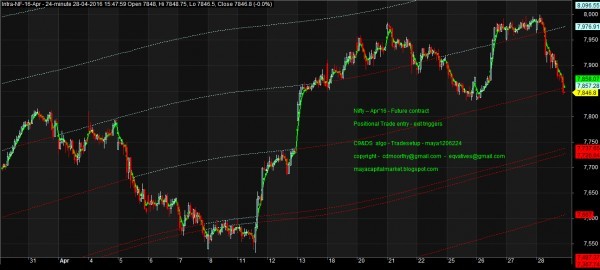
Also I wish to display – the performance review of same trading setup / system on Nifty June’16 futures contract - Intra day trade basis….
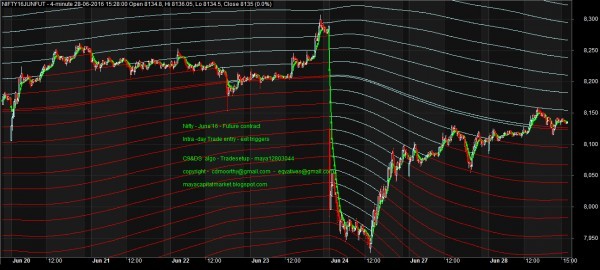
Editing - 01-07-2016 - 22.18 hrs --- Wish to Include - One more strategy / Trading system - for intraday trades:
Here, the algo generates important trade-able levels - based on historical OHLC data only.
As the entry / exit levels are pre-determined - during live trading sessions the trader will have a clear cut & Unambiguous view as to what to do... This system can also be machanized for Robot auto trade. At present trades are done manually as per entry / exit levels and I used to wait for the price action comes nearer to the level while entering, if there is gap up / gap down during opening session. I prefer One minute or lesser time frame and 50 % of the trades are closed when it hits 0.1% profits from the entry level (for currency) and 0.25 % for indices and the balance for the next target level. And the price point where 50% trades are booked would automatically becomes TSL in such case.
Screen shot of some portion of my algo (AFL ) - is presented here.
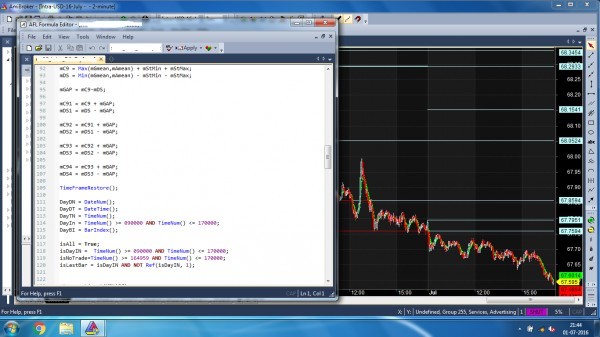
July 2016 USDINR - futures contract intraday chart - Plotted with intraday trade-able levels.
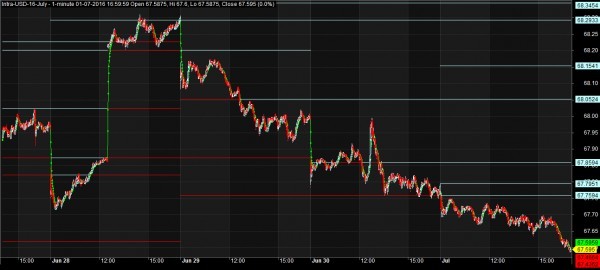
USDINR - Dec'15 & Jan'16 futures contract - intraday chart - 15min candles.... This is given only for having a birds eyeview / example purpose.... I prefer one min or lesser time frame while trading realtime.
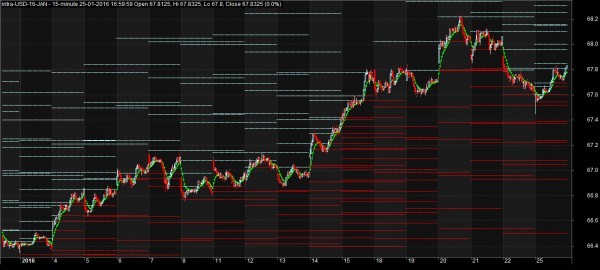
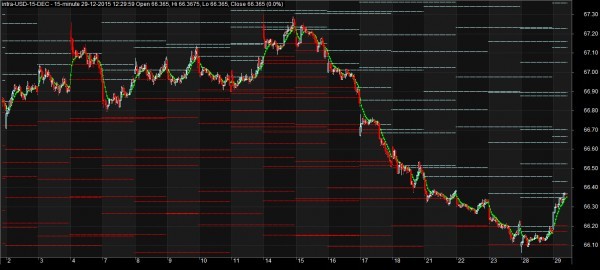
Wish you all Happy and Safe Trading.
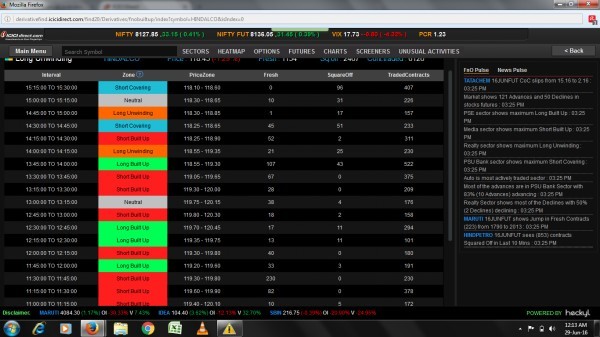
I
i use heckyl 15 min chart which gives me details how many new contract has been created or squarred off in 15 min duration.if squarred off count is low and continious short/long position are created.i sell call/put options.I have earned 10% today by shoting calls
Dont blindly follow free tips/advice. Tips are free but investment is money. Do some analysis before putting your money. Get to know what company is doing, what is their business model, how much growth they have, What is future plans, how much debt they have, how much dividend they give. So study their balance sheet or finance reports and invest.
my strategy is very simple. find out 52 week low or near 52 low company that have good outlook and buy only a small portion. add more if its go future. ones its give a reasonable return book profit.
Trading strategy …Haha , there is only one strategy that rules i.e to get profit no matter whatever logic you apply,but that’s an ideal stage, frankly speaking want that 10000 bucks so that I can use it to implement in a new strategy and even if I fail wont have a nightmare. I am just being honest.
Overview of my Trading System :
' Jean Pair Trading System ' - An Intraday System based on Mean Reversion.
I use this simple System for trading pairs on highly co-related stocks.
Entry & Exits are made using Moving Averages and based on Volatility & Price locations.
Pairs I trade : TM & TM-DVR, RInfra & RCap
A screenshot is attached below: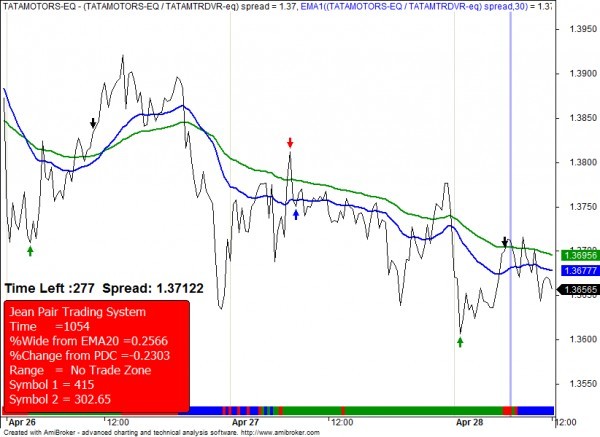
Hi Guys,
I Simply Underwrite The Bank Nifty Weekly Options (Selling Call Option And Put Options) !!! Just Predict The Unreachable Strike Price In Out The Money Options...For Safer Side Exclude 300 To 400 Points From Current Price And Just Simply Underwrite It !!! Cheers !!! This Is My Trading Method !!! Below Picture Is My Last Few Transactions !!!

My strategy
For Short term (1 to 2 months horizon)
Stock specific, sector specific
1. Sugar Sector- These stock has been hitting new highs. invest in sugar stock like trivani engineering.
2. Metal Stocks like Vedanta. High Beta, High Return, high risk.
3. Sunpharma- Buyback @ 900. 100% guaranteed riskfree return with (CMP- 763). If you want to take higher risk but with known exposure than buy Rs.800 strike price July 2016 call option.
For Long Term
1. PE Ratio, Book Value Ratio as compared to its peers & Future of Industry is seen. Like ITC is diversifying etc. Pharma ever growing like Sunpharma (After Ranbaxy merger).
Day by day answers are increasing , it's happy to read all answers.
It would be great if Star Traders from Opentrade share their overviews on trading Strategies since their trading records are available in opentrade.
Hi team Zerodha,
I am interested in Day trading as I have suffered a lot in positional trading… after having spent almost 2 years I have found that its not necessary to spend whole time (9.15 am to 3.30 pm) in trading.
My observations are as follows:
Market remains volatile from 9.15 am to 11.00 am so this is most important time if you are scalper.
Time between 11.00 am to 1.30 pm mostly every stocks consolidates so not necessary to spend your time just looking at charts.
From 1.30 pm to 3.10 pm volumes increases so We can trade at this moment.
I use Bracket Orders in futures (F&O) where I get much leverage from zerodha. ( Do learn about bracket orders it is really very useful for day traders)
See when I started I studied various indicators, but later came to know that Price action is more important that indicators because indicators depend on price. so for trading I see that recognizable candlestick pattern is formed.
For daytrading I use 2 min charts as it gives signal earlier than 5 min charts.
I search which sector is rising or falling in NSEindia site and select stocks which is top mover or loser. then check whether it is going up or down of its opening range. and take trade accordingly.
I keep Rs 17000 in my trading account which is enough to take 1 lot or any F&O stocks if you use Bracket Orders. which also secures me from losing very high amount.
Normally I earn close to Rs 1500 a day which is sufficient for me. ( I lose everytime when I try to experiment something new otherwise it is very simple and fine strategy without having any headache further We can do other activities as well.)
Thanks.
Index is weight and Stocks are weight lifter
I always try to trade in intraday and some time I use stop loss and gain less profit. Because when the market open I have money for investment and before market closing I sold my investment then next trading day I have money with profit or loss I don't depend my holding I depend in my own money. For example I BUY and SELL BPCL every day not for holding.
In Delivery trading I always BUY reputed and market leaders company stock because they always gain profit and more responsible
My trading is based on the following :
1) Trade only when odds of winning are in my favour.
2) Trade with a high reward to risk.So take a trade on small stops.
3) Trade the momentum so that the trade goes in profit quickly.
4) Trade with multiple timeframe concept. Here the trade is identified on higher timeframe but actual entry,stops and profit taking is done on smaller timeframe giving a higher reward to risk.
I track about 20 stocks mostly on hourly timeframes and look for best 2-3 stocks which satisfy the above critaria.This is done mostly at end of the day for trading on the next trading day.
Set Up on Higher Timeframe:
60 min chart .I look for an uptrend.A higher bottom and then some sideways consolidation .I am posting 60 min chart of Yes Bank June futures with the breakouts marked on the chart.

Trading Timeframe
My trading timeframe is 5 min. Once a setup is identified on higher timeframe, then trades are taken on 5 min swings above the breakout levels with stoploss at 5 min swing below the breakout level. Following 2 charts will show the entry and stop loss.Profit taking is 50% at 2 times the risk taken ,and 50% on 3 times the risk.

Another example :

Position Size : The position size depends on how far my stop is from my trade entry point.If I am tracking 3-4 stocks for trading on that day, then on each trade I will risk 0.5 % of the capital.If I cannot take trade in futures because of higher lot size,then trade in cash market intraday as we can trade smaller number of shares in cash market.
The above charts show the long trades. Mirror image for short trades.
My Strategy address my nature of Trading, i will be checking liquidity with volume & Open Interest and wait for correct opportunity. If market rises on low volume & Open interest, then the market is incorrect, and a short order would be the best way to enter a trade. If the market rises on large volume & Open interest,then the market is correct, and a long trade would be the best. This pattern would be reversed on a market that goes down.
I control my positions and hold them once they prove to be correct. If my taken position is proven wrong i will exit. I Keep my losses quick and small. I Use Stop Loss and Trailing Stop Loss
I will add larger position when am correct. I always want a larger position when we get a great move or trending market than when position isn't correct.I have a plan of adding position once a trend has established itself.
I do use Technical Analysis just to catch analyse the trend (Any of Trend based Indicator can give trend signal) and based on price action.
On existing positions when extreme liquidity takes place on trend. I book profit for half of my positions,
I keep Profit targets using probabilities based on research of particular stock
I believe in markets Money can be make only with Trading Skills and Skills will be improved with hours and hours of Disciplined Practice.
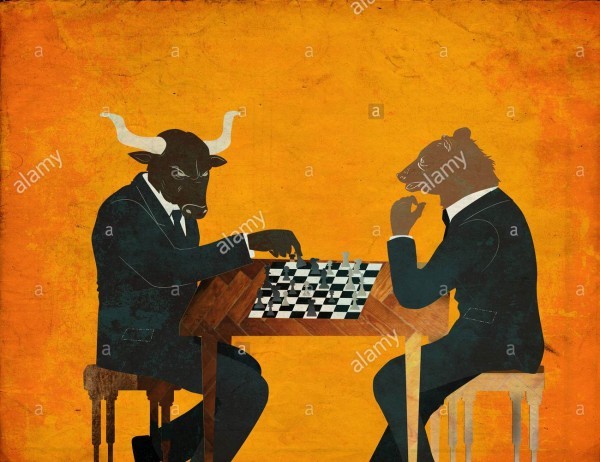
Hi,
To make best trade. I created my own trading strategy at my level best for Intraday.
1, First, i looked how to manage loss. So, i followed hedge method.
2, Hedge method is like trading using two trading accounts.
Example: Let we take BHEL - 110
* In first account, Make a BUY order @ 110
* In second account, Make a SELL order @ 110
=> You should know when and how to place square off for the both position to get proper profit.
=> Using Bracket Order, you can make profit by pre-planning and placing order.
=> If you unable to get profit, loss is managed here. Whatever the volatility.
I think this strategy will help everyone. It may look somehow complex, if you well-versed in that. You can trade without fear.
Thanks
Hi, I got to know about this contest from a fellow trader. Kudos to the entire team of Zerodha for taking on such a brilliant initiative. I will keep this short for obvious reasons, I don't want to be discussing my strategy with all the details but instead would like to give an overview for the readers to get a gist and the judges to make a fair assessment.
Asset Allocation
I have split my capital in the following way -
10% - Fixed Income
20% - MF’s - Long term investment
30% - Long term investments
40% - Active trading
Since this contest is about active trading, I will be talking only about that 40% of my capital.
The further split up on 40% is like this -
10% - Intraday trading
30% - Options writing
40% - Moment Portfolio
10% - Overnight Futures position
10% - Contingency capital
Why 10% for intraday ? This is because I do make a judicial use of leverage.
Intraday Strategy
I do 1 or at the most 2 trades per day and never beyond that. I trade only stocks from Nifty 50 basket as the liquidity is adequate and serves my purpose. The strategy largely involves identifying stocks which are showing signs of a breakout. These are stocks near strong support areas and invariably attracts large volumes. I particularly like situations where in the stock has just broken over the resistance makes a big move and retraces back to the resistance. I buy into such pullbacks and hold the position till EOD.
Option writing
Identify the mean and standard deviation of Nifty half way through the series. Identify call option strikes which are 3SD away, close your eyes and write them. Premiums are not much, but the chances of you retaining them are high. I even do option writing around corporate events, where the premiums are driven up by higher volatility. I think somewhere in Zerodha Varsity this is explained.
Momentum Portfolio
I buy into stocks and hold them as long as it qualifies to be held in the portfolio. The entire logic is based on this article from Economist, which I think makes sense, check this - http://www.economist.com/node/17848665 . The logic is simple stocks which have shown strength for the last 12 months, will continue to show strength for (at least) the 13th month, so buy them..hold for a month and re evaluate at the end of 13th month. Over the last year and half I have improvised on this and added my own filters, one example is that I do not venture out of CNX 500.
Overnight Futures Position
I identify stocks from my momentum portfolio which are showcasing strengths and buy into them overnight. Do note that because I'm selecting this from momentum portfolio it has already crossed some filtering mechanism so I do not over complicate this.
Contingency Capital
This is basically parked in liquidbees and this is earmarked for M2M requirements and few orportunities that just come up.
Other points
I do not hesitate to pledge my contingency capital and some of my portfolio stocks. I use this pledged amount for my intraday and option writing margins.
So this should give you a basic sense of my trading strategy.